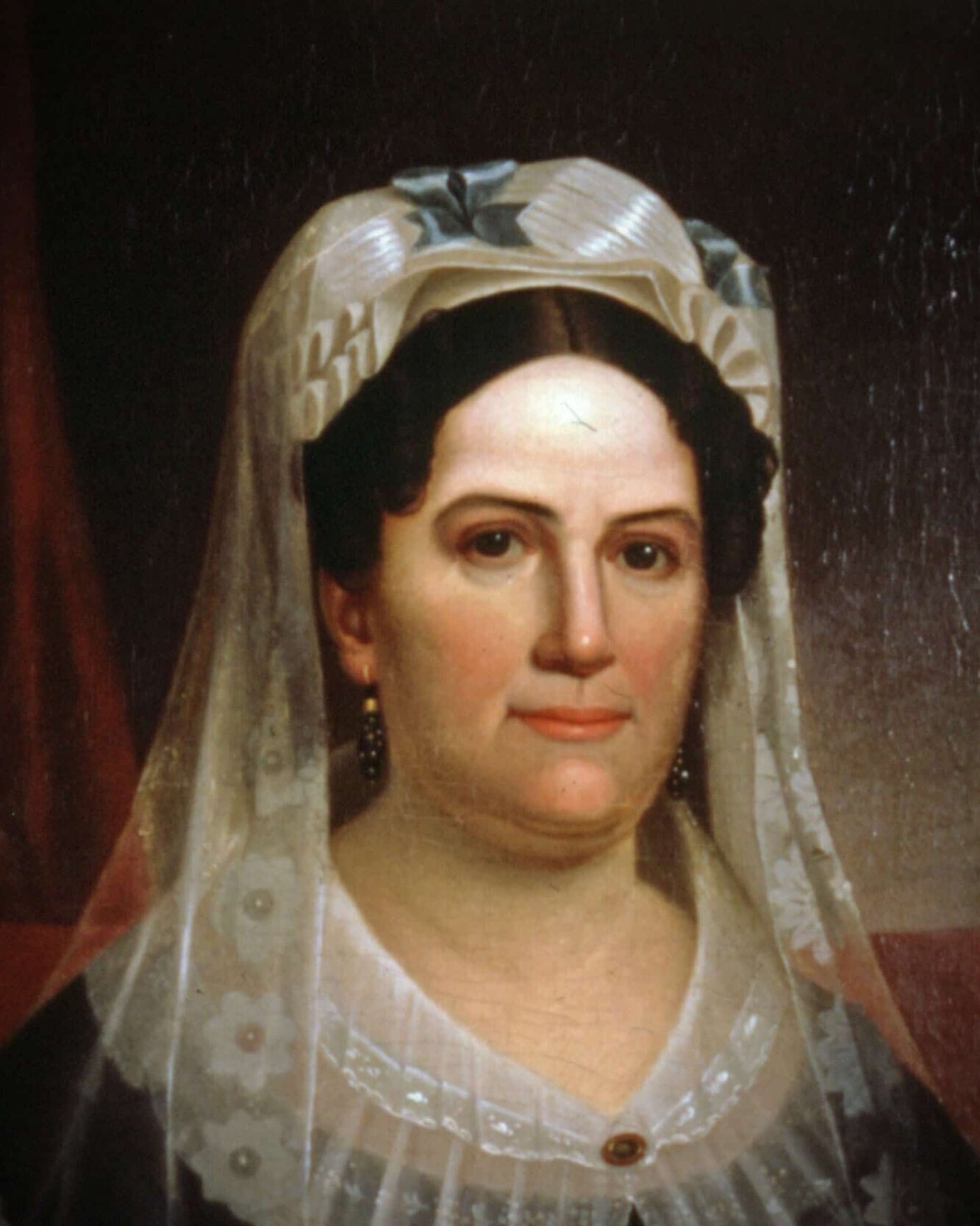We want to take you on a journey through the love story of Andrew Jackson and Rachel Donelson Robards, which was full of passion (and some controversy!). Despite their tendency to spend time together quietly at home, relaxing in the garden and enjoying family, their marriage sparked mystery and would be a source of debate throughout Jackson’s political career.
Our knowledge of Rachel’s story really begins in 1780 after Rachel and her family uprooted from Virginia to Tennessee. Due to the sustained threat of attack by Native Americans on the Cumberland, the Donelsons soon moved north to Harrodsburg, Kentucky (then part of Virginia). It was in Harrodsburg that Rachel married Lewis Robards at the age of almost 18. Soon after, her mother returned to Nashville, and Rachel’s father was killed under mysterious circumstances.
Their marriage did not fare well. What occurred is confused by accounts compiled in 1827 by Jackson’s supporters for his presidential campaign, which said Robards was insanely jealous and that he became angry over what he felt was Rachel’s flirtatious behavior with other men. Meanwhile, Rachel may have had difficulty adjusting to her new life. John Bassett, early 20th century biographer of Jackson, wrote that the young Rachel “is described as a woman of a lively disposition, by which is meant that she was not that obedient, demure and silent wife which some husbands of the day thought desirable.” A woman who is not obedient and demure would not fare well with a jealous husband.
In 1788, Rachel Robards left Kentucky for her mother’s home, allegedly because she and her husband were quarreling. Robards may have sent word to Rachel’s relatives to return to Kentucky to get her, or perhaps Rachel returned to her mother’s voluntarily to escape his temper. In any event, it was at her mother’s home near Nashville that she first met Andrew Jackson.
Having recently earned his law license in North Carolina, Jackson was sent to Nashville in 1788 from North Carolina to represent the state. At that time, Tennessee was still a part of North Carolina. He traveled in the company of several other ambitious young men, to make his livelihood in the expanding western economy. He boarded at the compound of Mrs. Donelson, sharing a cabin with John Overton, who was to remain his lifelong friend and sometime partner and adviser.
We don’t know if it was love at first sight. No written account by either of the two principals remains. Statements solicited on Jackson’s behalf in 1827 say that Rachel was a lovely, vivacious young woman. A 1954 article in the Winston-Salem Journal & Sentinel says that Lewis Robards described Rachel as “dark and saucy-eyed . . . and a good dancer.” Andrew Jackson was an impetuous young man. Perhaps she requested his protection from her husband, perhaps not. Robards came to Nashville in 1789 and tried for a time to be reconciled with his wife.
By the end of that summer, Rachel’s apparent friendship with Jackson caused local gossip to commence. Indeed, Robards heard soon that Rachel was involved with Jackson. Witnesses reported stormy arguments that summer between Robards and Rachel as well as altercations between Robards and Jackson. While serving as a guard party for Rachel and other ladies as they picked blackberries, Robards remarked to others that Jackson was too intimate with his wife. When the comment was reported to Jackson, he sought out Robards and threatened to “cut his ears out of his head” if he spoke of Rachel that way again. In another encounter, Jackson stopped Robards near the Donelson orchard “to remonstrate with him respecting the injustice he had done his wife.”
It is reported by researchers that Robards then left for Kentucky, vowing never to see Rachel again, while Rachel traveled to Natchez, Mississippi with a large party. The story was always that Jackson heard a rumor that Robards had obtained a divorce, so he hurried immediately to Natchez to marry Rachel. The Jacksons then returned to Nashville as a married couple. However, no record has been found of a marriage in Natchez, and the timeframe for these activities were confused by Jackson’s political friends in 1827.
Both Jackson and Rachel were young (then each only 22), and since no evidence exists that her divorce from Robards was complete at the time, their elopement was likely one of passion. Some say they took the frontier law into their own hands. Rachel was able to get out of a troubled marriage, while Jackson, an orphan with no formal education, gained an heiress with an influential network in the South.
Rachel did not come empty-handed to this marriage. As part of the settlement of her father’s estate, she received two slaves, George and Moll, and some household articles, which held a total value of $433.33 (roughly $12,000 in today’s terms). In addition, and more importantly, her large family was among the most prominent in the Nashville and surrounding area at the time.
After Lewis Robards finalized his divorce from Rachel in 1793, Andrew and Rachel Jackson legally married in January 1794. During the early days of their marriage, Jackson, like many other men, engaged in a variety of activities: lawyer, circuit judge, land speculator, farmer and storekeeper. His business partners included two of Rachel’s relatives, her nephew John Hutchings and her younger brother Samuel. In March 1796, Jackson purchased Hunter’s Hill, a 640-acre tract on the south bank of the Cumberland River. Here he and Rachel built a two-story house with clapboard siding, said to have been one of the more handsome houses in the area at that time. They sold that property in 1804 and moved to adjacent Hermitage property that same year.
Their love and devotion for one another was strong. Accounts note Rachel steadied him. It was her devout faith that made her the moral center of the Jackson family. She brought Jackson closer to religion. While his military career often took him from home into war, the constant that steadied him was knowing that his wife Rachel, a devout Presbyterian, was at home praying. She used her influence to bring Jackson closer to religion, and he famously promised her that, when free of politics, he too would join the church.
He kept to that promise and began building a church in 1823 for Rachel and the local community. The Hermitage Church was completed in 1824 and served as a Presbyterian church until 1965, when fire destroyed the structure, leaving only brick walls. The Andrew Jackson Foundation bought the church remains and rebuilt it in 1968. The Hermitage Church has since undergone several preservation projects, all respecting the love Jackson had for Rachel.
Andrew and Rachel Jackson were deeply devoted to each other. During his travels as a general, he often took Rachel with him, not wanting to be apart. Records show she accompanied to Florida, New Orleans and Washington. On the occasions when they were apart, though, they often wrote letters to each other.
Rachel’s letters indicate how greatly she missed Jackson and worried for his safety. “What a vacuum is in my soul [when] you are absent,” she wrote in one letter, and in another, “You have been gone a long time, six months, in all that time what has been your trials, dangers and difficulties, hardships, oh lorde of heaven how can I bare it. . .” She said she was miserable without him and that she suffered from sick headaches and sometimes could not sleep for crying.
Andrew and Rachel never had any biological children of their own, yet there were always children living at The Hermitage. When Rachel’s brother and sister-in-law gave birth to twin boys, the Jacksons adopted one of them as their own in 1809. Named Andrew Jackson Jr., he would grow up at The Hermitage but also remain close to his biological parents, brother (who was also his cousin after the adoption), aunt and uncle. He went on to marry and have five children of his own.
Unfortunately, Rachel passed away just before Jackson departed for Washington to begin his presidency. Jackson continued to mourn for Rachel until the end of his life. The garden, which had been such a source of joy to her during her later years, became a sort of shrine after her death. Initially a little house was constructed over her grave, and four weeping willow trees were planted around it. In April 1830, Jackson wrote to a nephew, Samuel Jackson Hays, “. . . give me a faithful description of the garden, of the tomb of my dear wife and whether the roses and flowers, which I directed planted around it, has been so planted and whether a row of flowers between the house and front gate is attended to. . . That garden is now to me a consecrated spot, and I wish it carefully attended to, particularly the square around the sacred Tomb. . . ”
He regularly demanded to know whether flowers planted by Rachel were being watered and cared for, whether the willow trees had survived a killing frost and whether some hickory nuts presented to him had been planted near the tomb as he had directed.
Apparently the garden was neglected for a while, perhaps during the period when the burned house was being rebuilt, because in 1835 he wrote to Andrew, Jr., “How I am delighted to hear that the garden has regained its former appearance, that it always possessed whilst your dear mother was living, and that just attention is now paid to her monument. . . ” The limestone temple that stands over the tombs of Jackson and Rachel was completed in 1833. Their granddaughter, “Little Rachel,” recalled that during his final years, Jackson went to the garden each evening to sit by the graveside. There is no doubt that he missed Rachel greatly.
Although Rachel Donelson and Andrew Jackson did in truth flaunt the moral and legal codes of their times, today they stand as legendary lovers. If his most determined critics admire Andrew Jackson for anything, it is his devoted marriage to Rachel and his vigorous defense of her reputation.
With deep roots in U.S. history, venues like the Hermitage Church and the Hermitage garden are symbols of the love and commitment between partners. These historic sites offer storied glimpses of the past and beautiful beginnings for couples today.








